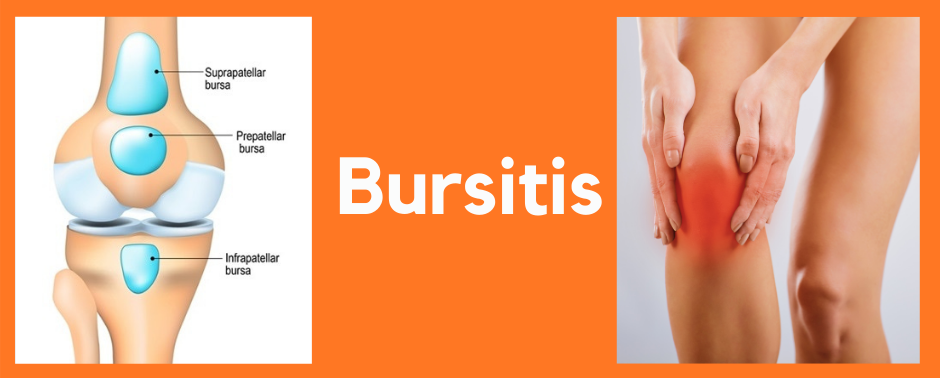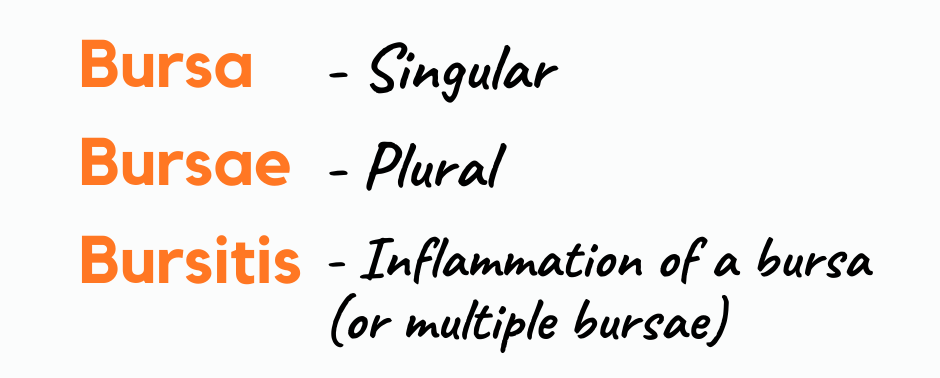Bursitis

A bursa is like a small cushion that sits between your tendons or muscles, and the bones close to them. When your feet or legs move and you use and move your muscles and tendons, instead of them accidentally rubbing against nearby bones which can lead to friction and pain, your bursae are perfectly positioned so that the tendons glide against them and their smooth, lubricating surfaces instead.
This role of bursae is very important for your body, enabling you to walk, run and move comfortably and without constant pain after even a gentle walk. Hence, you have over 150 bursae all throughout your body, working to cushion and lubricate tendons anywhere that they are in close proximity to your bones.

What is bursitis?
Bursitis is the term for an inflamed bursa. Like all structures in our bodies, bursae have a limit of the stress that they can take on before they need rest and repair. When this is exceeded, and they are overused, a bursa can become injured, and inflammation is a response to this injury.
As we engage our feet and legs every time we walk, the bursae in the feet and legs are more prone to overuse and bursitis. Hence, we often see bursitis at the back of the heel, the forefoot and the knee.
 Is overuse the cause of bursitis?
Is overuse the cause of bursitis?
In the majority of cases that we see and treat, yes, though other causes do occur. This can be from trauma to the area containing the bursa (like dropping something on your foot), certain medical conditions (particularly inflammatory conditions like types of arthritis), infections in your body and more.
We also often see bursitis occurring together with other overuse injuries like tendinopathies. This makes sense – if the tendon is being used so much that it overuses the bursa, then it’s not surprising that the tendon itself may incur some damage in the process, too.
What does bursitis feel like?
Anytime you have swelling in a part of your body, pain is usually present when feeling around that area, applying pressure to it, or using the muscles in that area. If the bursitis is present in your foot, this may make it uncomfortable or difficult to walk. Swelling also often brings with it warmth and redness, may leave you feeling stiff or like your movement is restricted.
How is bursitis treated?
Bursitis is treated by addressing the cause of the damage to the bursa. If this is from overuse, which often is, we’ll consider:
- Which activity is causing the rubbing/overuse?
- What other factors are involved – is the tendon tight and inflexible? Are your foot and leg biomechanics playing a role? Is your footwear influencing the overuse? Is it your technique?
- Your occupation and lifestyle – what do you need to keep being able to do daily? We always consider how the treatment we prescribe affects your daily life, as we know that patients will stick to and get the best results from treatment plans that are genuinely sustainable for their daily activities and lives
We’ll always conduct a comprehensive assessment to understand all the characteristics and biomechanics of your feet and legs and how they’re being used. From there, we’ll make a plan that will start by relieving your pain and uncomfortable symptoms, then focus on letting the bursa heal and repair, and then plan for how we can help you prevent your bursitis from happening again.
We have a wide range of treatments and will discuss with you the ones that will help you get the best results for your circumstances. This may include foot mobilisation therapy, gait retraining or technique changes for activities performed at work or in sports, custom foot orthotics, footwear changes, temporary padding or strapping, and more.
Will my bursitis come back?
If you damage your door frame every time you close your door, to the point that it breaks and then you replace it, can the new door frame be damaged and broken again? Absolutely. The same applies to bursitis. The difference is that we’ll help you put the right measures in place so that when you close your door, the doorframe won’t get any damage in the first place.
FAQs
How long does it take to recover from bursitis?
We typically see cases of bursitis resolve within four to six weeks – sometimes even within one or two weeks depending on the location of the bursa that has been affected and the severity.
How can I help my bursitis at home?
You can help manage the painful symptoms of your bursitis at home by applying ice to the painful, swollen area for 20 minutes at a time, 3-4 times per day. This will help manage your pain until you are able to see a podiatrist. Avoid any activities that bring on the pain, as these will likely be putting more pressure on your damaged bursa. Continue to wear good, supportive shoes both inside and outside the home, presuming they don’t rub and push against a bursa.
What are the most common places for bursitis to develop?
We often see bursitis in the back of the heel, the big toe joint, the front of the knee, the back of the knee – and even in the side of the hip joint. With this said, you have over 100 bursae around your body, so there are lots of areas in the feet and legs where bursitis can develop.
How can I reduce the likelihood that my bursitis will recur in the future?
Your podiatrist will discuss the best ways to help prevent the recurrence of bursitis in the future based on the cause of your current bursitis, your foot and leg biomechanics, and your circumstances. This may include a combination of calf stretching and other strengthening exercises that will help relieve the pressure and strain away from the vulnerable bursa, as well as wearing your orthotics (if prescribed) that may help offload vulnerable areas of your foot.
Does ACC cover treating bursitis?
If your injury was sustained as a result of an accident, then you may be eligible for ACC. We will fill out your paperwork and submit a claim, it is up to ACC whether or not you are covered.


